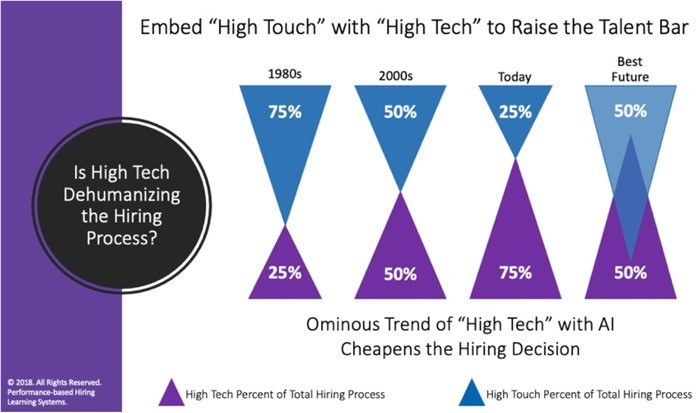Recruiting Lessons From the 80’s That Will Help You Improve Quality of Hire Now
When I started as a recruiter in the 1980s, these things were true:
- If you knew the actual job needs in detail and the hiring manager personally, you only needed to present 2-3 strong candidates to make a placement.
- You’d normally only need to talk with 8-10 reasonably strong prospects to wind up with 2-3 strong candidates. Half of these strong candidates were typically referrals from the group of prospects.
- The primary tool used to find these initial prospects was a directory of companies by industry that listed their products, main phone numbers, and an outdated list of the names of their senior executives.
- It only took 4-5 days of phone calls to generate 2-3 strong candidates. This dropped to 2-3 days once you developed a deep network of top prospects.
- The cost per hire was the search fee, but if the person was a top performer this was insignificant from an ROI standpoint.
This “high-touch” approach is shown on the left side of the infographic labeled “1980s.”
With the birth of the Internet and job boards in the 1990s and the emergence of ATS around 2000, the high-touch, “quality is #1” approach was losing favor. Companies thought they could “win the war for talent” using technology to reduce the cost per hire.
This “high-tech” trend of replacing “high-touch” accelerated over the past 20 years. New ATS and AI vendors came along, plus there was a rise in major job boards promising qualified candidates in days.
Despite this huge and growing investment in technology, little has changed. There is little evidence that quality of hire, cost per hire, time to fill, retention, job satisfaction, and job performance has improved. The reasons are obvious: By opening up the candidate pool to anyone, countermeasures in the form of new technology were needed to maintain some level of order and efficiency. As a result, any efficiency savings were offset by more overhead costs with a corresponding decline in quality of hire.
How to combine "old fashioned" recruiting tactics with new technologies
By embedding old-fashioned, high-touch concepts earlier into the process, technology can be used to hire for performance and fit rather than skills and efficiency. Here are some ideas our clients have used to successfully make this transition.
- Use compelling multimedia stories instead of boring job descriptions. This is story-based job posting but imagine it with a video by the hiring manager.
- Add a two-step application process. Change your application process to require those who want to be “official” applicants to submit a short write-up of an accomplishment most related to real job needs. Here’s the legal basis for this. This two-step process will self-eliminate 90% of all candidates resulting in huge cost and efficiency savings.
- Talk to fewer pre-qualified prospects. Narrow your sourcing to people who are performance-qualified, those who possess the Achiever Pattern, and those who see your role as an obvious career move. This increases the odds that someone will respond to an email and ensures hiring managers will see these people and likely make an offer that will be accepted.
- Nurture and network. Sell the exploratory discussion, not the job. By removing the time pressure, using multiple contact techniques and going slower, you’ll actually speed things up and get great referrals in the process.
- Phone screen everyone without video. Use this validated phone screen to determine if the person can do the work, fit with the culture, raise the talent bar, and shift the conversation to career growth over compensation. This is the heart of the high-touch process and when implemented successfully, it improves quality of hire while eliminating wasted time, noise, bureaucracy, and overhead.
- Assess performance and potential vs. skills and presentation. Use this one question to determine if the person can actually do the work, not just talk about it.
- Recruit for long-term growth, not short-term compensation and convenience. Don’t hire anyone until you get the right answer to this question, “Forget the money, why do you want this job?” The right answer needs to consist of a complete understanding of the performance requirements of the job and why it represents a career move.
Making this transition is not easy, but it starts with the idea that the best people don’t change jobs the way the technology wants them to change. That’s what makes them the best people. As you’ll discover, this concept is as true today as it was in the good old days when quality of hire was #1.
To receive blog posts like this one straight in your inbox, subscribe to the blog newsletter.
Topics: Quality of hire
Related articles





